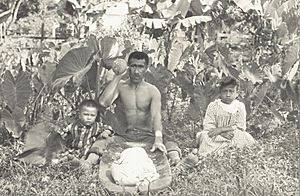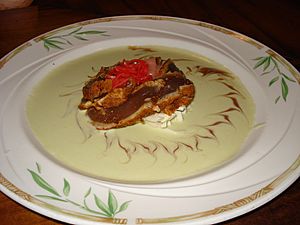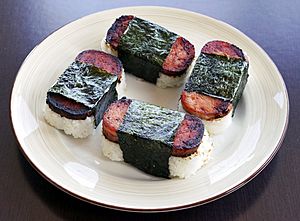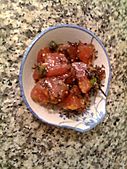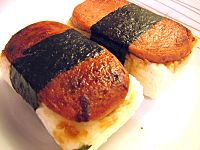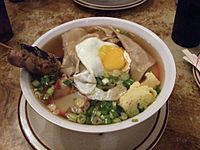Cuisine of Hawaii facts for kids
The cuisine of Hawaii is a mix of different food styles. It shows the many groups of people who have settled and moved to the Hawaiian Islands over time.
Long ago, from 300 AD to 1778, Polynesian explorers sailed to Hawaii. They brought plants and animals with them. The Native Hawaiians fished and grew taro to make poi. They also planted coconuts, sugarcane, and sweet potatoes. They cooked meat and fish in earth ovens.
After 1778, Europeans and Americans arrived. They brought their own foods and started large sugarcane farms. Christian missionaries introduced New England cuisine. Whalers brought salted fish, which later became lomilomi salmon.
Between 1850 and 1930, many workers came to Hawaii for the farms. They came from China, Korea, Japan, the Philippines, Puerto Rico, and Portugal. Each group brought their unique foods, like Chinese manapua, Portuguese sweet bread, and Japanese bento.
All these different foods mixed together. This created a special "local food" style unique to Hawaii. Examples include the plate lunch, Spam musubi, and loco moco. After World War II, chefs started to create "Hawaii Regional Cuisine." This style uses local ingredients to blend all of Hawaii's food influences.
Contents
History of Hawaiian Food
Ancient Times: Before Contact
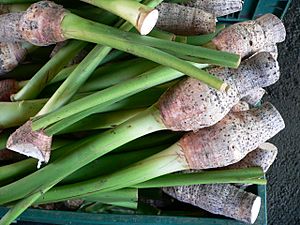
When Polynesian sailors first arrived in Hawaii around 300–500 AD, there were not many edible plants. The voyagers brought about 27 to 30 plants with them. These are called canoe plants because they were carried on canoes. The most important plant was taro.
For hundreds of years, taro and poi made from it were the main foods. People still love poi today. The Polynesians also brought sweet potatoes. They are thought to have come from contact with the New World.
The first settlers from Polynesia, the Marquesans, brought breadfruit. Later, Tahitians brought baking bananas. They also brought coconuts, candlenuts (called kukui nuts), and sugarcane. They found plenty of fish, shellfish, and seaweed in Hawaii.
Ancient Polynesians sailed with pigs, chickens, and dogs. Pigs were sometimes used for religious ceremonies. The early Hawaiian diet was very varied. It included many types of seafood and sweet potatoes.

Sea salt was a common seasoning. Inamona was a relish made from roasted, mashed kukui nuts and sea salt. Sometimes seaweed was added.
Important events were celebrated with a traditional feast called ‘aha‘aina. Today, these feasts are called lū‘au. The name lū‘au comes from a dish always served at these feasts. It is young taro tops baked with coconut milk and chicken or octopus.
Large meats, like pigs, were cooked in earth ovens called imu. This method is called kālua. A pit was dug and lined with hot rocks. Food wrapped in leaves was placed in the pit. It was then covered with more leaves and earth. Water could be added to create steam.
The hot rocks cooked food thoroughly. People could cook enough food for several days at once. Sweet potatoes, taro, breadfruit, and fish were cooked in the imu. Chickens and pigs were also cooked this way. In ancient times, men did all the cooking. Men and women ate separately. Cooking with the imu is still done today for special events.
New Arrivals: After Contact
In 1778, Captain James Cook arrived in Hawaii. He brought animals like goats, pigs, and seeds for melons and onions. In 1793, Captain George Vancouver brought the first cattle. These cattle multiplied quickly. King Kamehameha I hired John Parker to manage them. This led to beef being added to Hawaiian food.
In 1813, pineapple was first grown in Honolulu. Don Francisco de Paula Marin, a Spanish botanist, planted it. Marin also tried growing grapes and coffee. He experimented with many other fruits and vegetables.
By the late 1800s, pineapple and sugarcane farms grew very large. They became very important for Hawaii's economy.
Foods from Different Cultures
As the big farms grew, they needed more workers. Immigrants came from China, Korea, Japan, the Philippines, and Portugal. Each group wanted their own foods. They started farms and stores to get them.
Chinese immigrants brought Cantonese cuisine. They introduced stir-fries, sweet and sour dishes, and dim sum. Rice became more popular than poi.
Korean immigration to Hawaii brought kimchi and barbecue cooking. Korean bulgogi (marinated beef) and galbi (marinated ribs) became popular. Bibimbap (mixed rice with vegetables) also became a part of Hawaiian food.
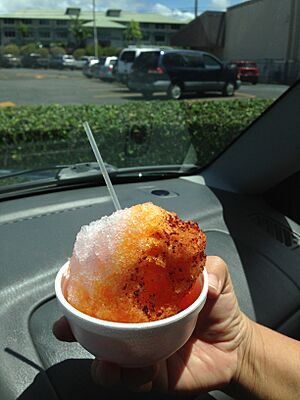
Portuguese immigrants came in the late 1800s. They brought foods with pork, tomatoes, and chili peppers. They built special ovens to make pão doce (sweet bread) and malasadas (donuts).
The Japanese brought bento boxes and sashimi. They also made tofu and soy sauce. Japanese cooking often used frying, steaming, and broiling. This made tempura and noodle soups popular in Hawaii. By the early 1900s, Japanese people were the largest group. Rice became a major crop.
Puerto Rican immigration to Hawaii started in 1900. They added spicy soups, casseroles, and pasteles (meat turnovers).
Filipinos arrived in 1909. They brought peas and beans. Their adobo style of cooking with vinegar and garlic became popular. They boiled, stewed, and fried food. Sweet potatoes were also a main food for them.
Samoans arrived in 1919. They built earth ovens above ground. They made poi from fruit instead of taro.
After the Vietnam War in 1975, people from Southeast Asia came. They brought ingredients like lemongrass, fish sauce, and galangal. These are popular in Thai and Vietnamese cuisine.
Modern Times: From Territory to State

The first restaurant in Honolulu opened in 1849. It was called the "eating house." More restaurants followed, like the "Parisian Restaurant."
In 1872, the Royal Hawaiian Hotel opened. It was a fancy hotel that served European-style dishes.
Hawaii's huge pineapple industry began in 1901. James Dole, known as the "Pineapple King," started growing pineapples on Oahu. In 1922, he bought the island of Lanai for even more pineapple farming. By 1950, his company was the largest pineapple company in the world.
In 1905, Governor George R. Carter wanted Hawaii to grow more local food. He wondered why local guavas were rotting while pineapples were being planted. These ideas led to the "grow local, buy local, eat local" movement much later.
Since the 1970s, pineapples have been grown more cheaply in Southeast Asia. So, Hawaii now grows many other crops. These include squash, tomatoes, chili peppers, and lettuce.
In the 1950s, baker Robert Taira created a Hawaiian version of Portuguese sweet bread. His company, King's Hawaiian Bakery, became very successful.
Hawaii Regional Cuisine
Hawaii Regional Cuisine is a special cooking style. It was created by a group of twelve chefs in 1992. This style uses local ingredients like seafood, beef, and tropical fruits. It mixes all the different food influences in Hawaii.
The chefs wanted to use local ingredients instead of shipping food from far away. They wanted to show the world Hawaii's unique food culture. Their goal was to connect local farmers, fishermen, and ranchers with restaurants. They changed hotel menus from imported foods to dishes made with local ingredients.
These chefs also published a cookbook called The New Cuisine of Hawaii in 1994.
Today's Hawaiian Food Scene
Hawaii is a popular place for tourists. This has led to Hawaiian-themed restaurants opening in other parts of the United States. You can find places like Ono Hawaiian BBQ and L&L Hawaiian Barbecue. Hawaiian food is even reaching Europe.
Many Hawaiian specialties are now famous. These include Mauna Loa macadamia nuts. Some old companies like Alexander & Baldwin (sugarcane) and Dole Food Company (pineapple) are still active. New local food businesses are also growing.
Popular local eateries include the Zippy's chain and Foodland Hawaii grocery stores. Historic places like Kanemitsu Bakery and Helena's Hawaiian Food are still around. Chefs like Roy Yamaguchi have also helped make Hawaiian cuisine famous.
Main Ingredients
Vegetables, Fruits, and Nuts
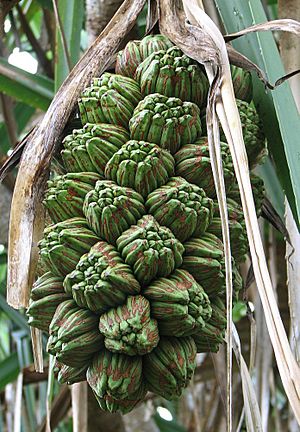
- Taro (Colocasia esculenta) – An ancient plant used for over 30,000 years. The wet-land type is best for poi. The dry-land type is crispy and used for taro chips.
- Breadfruit (Artocarpus altilis)
- Sweet potatoes
- Candlenut (Aleurites moluccana) or kukui – Roasted nuts used in inamona, an ancient Hawaiian seasoning.
- Coconut (Cocos nucifera)
- Polynesian arrowroot (Tacca leontopetaloides) or pia plant – Used to thicken desserts like haupia, a coconut cream pudding.
- Ti (Cordyline fruticosa) – The root was used to make a liquor called okolehao. The leaves are used to wrap food cooked in the imu earth oven, like laulau.
- Winged bean (Psophocarpus tetragonolobus)
- Jicama
Spam
Spam, a canned meat, has been very popular in Hawaii for many years. Hawaiians eat more Spam per person than almost anywhere else in the world. American soldiers brought Spam to Hawaii during World War II. It became an important source of protein when fishing was limited. In 2005, Hawaiians ate over five million cans of Spam!
Spam is used in many local dishes. It is often fried and served with rice. For breakfast, it is served with fried eggs. Spam can also be roasted, deep-fried, or stir-fried with cabbage. It is added to saimin (noodle soup) and fried rice.
Spam musubi is a very popular snack. It is a slice of fried Spam on rice, wrapped with a strip of nori (seaweed). It became popular in the 1980s.
Beef
In the 1800s, Mexican cowboys came to Hawaii to teach Hawaiians about cattle ranching. The Hawaiian cowboys were called paniolos.
Cattle ranching grew for 100 years. The paniolos ate pipikaula ("beef rope"). This is salted and dried beef, similar to beef jerky. Pipikaula is often grilled. With Asian influences, beef strips are now often marinated in soy sauce.
Fish and Seafood
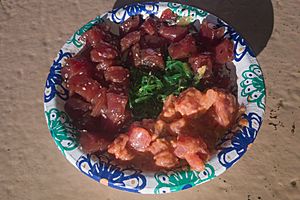

Tuna is a very important fish in Hawaiian food. Types include skipjack tuna (aku) and yellowfin tuna (ahi). Ancient Hawaiians used ahi on long trips because it kept well when salted and dried. Much of the local tuna is sent to Japan for sashimi. In Hawaii, tuna is eaten as sashimi, grilled, or made into poke.
Other popular fish include marlin (kajiki), swordfish (shutome), and groupers (hapuu). The red snapper (onaga) and pink snapper (opakapaka) are often steamed or baked. Wahoo (ono) and mahimahi are usually grilled or fried.
Poke is a local dish. It started with preserving raw fish or seafood like octopus with sea salt. The fish was rubbed with seasonings or cut into small pieces. Traditional seasonings included seaweed, kukui nut, and sea salt. After Western and Asian cultures arrived, scallions, chili peppers, and soy sauce became common additions. Poke is different from sashimi because it is usually cut more roughly and can use less expensive fish parts. In the 1970s, poke became a popular snack to have with beer or at parties.
Spices
Because of the island's Asian influences, teriyaki is a very popular way to prepare meats. Other common Asian spices include five-spice powder from China, wasabi and shoyu (soy sauce) from Japan, and bagoong from the Philippines. A local Hawaiian soy sauce is called aloha shoyu.
Popular Hawaiian Dishes
- Chicken long rice – Chicken cooked with broth, ginger, green onions, and long rice noodles.
- Kalua pig – Pulled pork that is marinated and steamed with cabbage.
- Crack seed – Dried, preserved fruits and seeds, often sweet, sour, or salty.
- Lau lau – Steamed fish and pork wrapped in taro leaves and a ti leaf. It can also have chicken.
- Loco moco – Hamburger patties with gravy, topped with two fried eggs, usually served with rice.
- Lomi salmon – Cubed salmon mixed with tomatoes, Maui onions, and chili pepper.
- Luau – A stew made from taro leaves.
- Malasada – A Portuguese donut that is deep-fried and coated with sugar.
- Manapua – A Hawaiian Pidgin word for cha siu bao, a steamed bun usually filled with char siu (barbecue pork).
- Mochi – A Japanese dessert made from glutinous rice.
- Musubi – A rice ball, often with a filling or topping.
- Opihi – Edible limpets (small sea snails).
- Pasteles – Puerto Rican meat pastries.
- Plate lunch – A meal with rice, a main dish (like meat or fish), and macaroni salad.
- Poi – Mashed taro root, a traditional Hawaiian staple.
- Portuguese sweet bread – A soft, slightly sweet bread.
- Saimin – A noodle soup with wheat noodles, served in a hot broth. It is garnished with green onions, kamaboko (fish cake), and char siu.
Drinks
- Kava (Piper methysticum) (ʻawa) – A traditional relaxing drink from Oceania. Today, kava bars are popular in Hawaii. Kava is grown on Maui, Molokai, Kauai, and Oahu.
See also
 In Spanish: Gastronomía de Hawái para niños
In Spanish: Gastronomía de Hawái para niños



